Dear Friends, Find the list of important Reasoning Test Questions 20-20 for upcoming SBI PO Mains and competitive exams. We regularly provide 20 reasoning test questions daily for students. Aspirants practice these questions on a regular basis to improve your score in reasoning section. Aspirants preparing for the exams can make use of this 20-20 Reasoning Questions. Here we have started New Series of Practice Materials specially for SBI PO Mains 2018. Aspirants those who are preparing for the exams can use this “20-20” Reasoning Questions.
[WpProQuiz 2936]
Click “Start Quiz” to attend these Questions and view Explanation
Direction (1-5): Read the given information carefully answer the questions given below.
Eight People A, B, C, D, E, F, G and H are born in eight different months in a year. Consider all the people are born in same year. The months are started from January to August. Each of them likes different beverages namely Badam drink, Coffee, Tea, Milkshake, Rose milk, Milk, Jigarthanda and Apple Juice. All the information is not necessary to be in the same order.
B does not like Coffee. More than two people lives between H and E, who does not like Jigarthanda. Only two people lives between the person who likes Badam drink and the person who likes Coffee. The person who likes Milkshake was born in the month which contains 31 days. D likes Milk. The person who likes Badam drink does not born in the month which contains 31 days. G was born in the month of June. The person who likes Tea was born immediately after the person who likes Milkshake. The person who likes Milk is not younger to the person who likes Milkshake. Only three people lives between D and C. The person who likes Milkshake was younger than the person who likes Coffee. The person who likes Tea was born neither in March nor in June. Only one people born between the person who likes Apple Juice and the person who likes Jigarthanda, who is neither born in January nor in nor in April. The person who likes Apple juice is elder to A. G does not like Jigarthanda. D does not born immediately before G. A does not like Milkshake. F was born immediately after B, both of them neither likes Jigarthanda nor likes Milkshake.
1) The person who likes in Milk was born in which of the following month?
a) January
b) May
c) July
d) April
e) None of these
2) How many people lives between the person who likes Apple Juice and the person who born in the month of August?
a) Six
b) Seven
c) Three
d) Four
e) None of these
3) Name the person who likes Tea?
a) A
b) C
c) E
d) B
e) None of these
4) In which month does the person who likes Badam drink was born?
a) January
b) May
c) July
d) February
e) None of these
5) The person who was born in the month of June, likes which of the following beverages?
a) Apple Juice
b) Tea
c) Coffee
d) Rose Milk
e) Badam drink
Direction (6-10): Study the following information carefully and answer the given questions.
A number arrangement machine arranges two digit numbers into a typical manner. Each step gives output taking input from the previous step. The following is an illustration of Input and rearrangement. Using the illustration answer the question given below.
6) Which of the following number is in second digit of second number in Step II?
a) 25
b) 10
c) 30
d) 6
e) None of these
7) What is the difference of first digit and second digit of first number in Step III?
a) 10
b) 5
c) 6
d) 9
e) None of these
8) Which of the following number is in Step IV?
a) 50
b) 65
c) 90
d) 86
e) Cannot be determined
9) Which of the following is second number in Step IV?
a) 15
b) 40
c) 9
d) 65
e) None of these
10) What is the difference of first digit of first number and second digit of third number in Step 1?
a) 1
b) 3
c) 4
d) 2
e) None of these
Direction (11-15): Read the given information carefully answer the questions given below.
Seven people P, Q, R, S, T, U and V are in different ages are sitting in the linear table, some of them faces south and some of them faces north. Each of them takes leave on seven different days in a week. The week days starts from Sunday to Saturday. Their ages are viz., 15, 21, 29, 32, 38, 40 and 56. All the information is not necessary to be in the same order.
P sits second to the right of Q, who is an immediate left of the youngest person. The Person who takes leave on Wednesday sits at extreme end of the table. The person whose age is 40 is leave on Monday. R sits second to the left of T. R sits at extreme end of the line. Only two people sits between R and the person whose age is 32. The person who takes leave on Tuesday sits second to the left of the person whose age is 32. P’s age is 38 and he takes leave on Saturday, who is not immediate neighbour of the person whose age is 32. The person whose age is 38 sits immediate left of the person whose age is 40, who does not sit second to the right of the person whose age is 32. The person who sits at corner of the table faces same direction. The person who takes leave on Thursday sits third to the left of the person who takes leave on Wednesday. U takes leave on first day of the week, who does not sits at extreme end of the row. U is not elder than S. The person who takes leave on Tuesday was 21 years old. The eldest person of the group is V, who sits second to the right of U. U faces North. V not takes leave on Wednesday. R not takes leave on Friday. Immediate neighbour of R faces same direction of R. U sits immediate left of S. The person who takes leave on Monday does not sit at extreme end of the line.
11) If all the people are made to sit in alphabetical order from left to right, then how many of them will remains in their original position?
a) One
b) None
c) Three
d) Two
e) More than three
12) What is the age of the person who sits fourth to the right T?
a) 56
b) 40
c) 29
d) 38
e) None of these
13) Which of the following information is definitely true based on the given arrangement?
a) Only five people faces north
b) P sits at the middle of the row
c) S is the second eldest person in the group
d) Only three people sits between P and S
e) None of these
14) Name the person who sits second to the left of Q?
a) The one who takes leave on Monday
b) The one who takes leave on Tuesday
c) The one who takes leave on Friday
d) The one who takes leave on Wednesday
e) None of these
15) Name the person who sits fifth to the left of S?
a) The one whose age is 40
b) The one who takes leave on Monday
c) The one who takes leave on Sunday
d) The one whose age is 29
e) None of these
Direction (16-18): In each question below a statement is followed by two assumptions numbered I and II. An assumption is something supposed or taken for granted. You have to consider the statement and the following assumptions and then decide which of the assumptions is implicit in the statement. Give answer :-
a) if only assumption I is implicit.
b) if only assumption II is implicit.
c) if either assumption I or II is implicit.
d) if neither assumption I nor II is implicit.
e) if both assumption I and II are implicit.
16)
Statement: Polavaram Project is a multi-purpose irrigation project which has been accorded national project status, which is implemented by Andhra Pradesh. The project aims to benefit farmers directly and indirectly and also reduce the shortage of drinking water.
Assumption I: Andhra Pradesh has taken many steps to raise underground water level by constructing dams and by implementing rain water harvesting method.
Assumption II: Andhra Pradesh government has taken necessary steps to produce maximum agriculture products with minimum available water.
17)
Statement: Haryana’s Godikan village panchayat has passed a ‘No Toilet, No Bride’ resolution, becoming the first panchayat in the country to do so.
Assumption I: Haryana government has taken several measures to make the hygiene India.
Assumption II: The government of Haryana has taken several steps to decrease the mortality rate due to pollution and microbes
18)
Statement: Indian Railways will become a “net zero” carbon emitter by 2030, with the current action plans on anvil for 100 per cent electrification, coupled with renewable strategies.
Assumption I: Railway minister Piyush Goyal launched the Railway Insurance scheme to bear the risk of passengers while travelling.
Assumption II: The Indian railways have recently launched the bio-toilets to control the dirty in railway tracks.
Direction (19-20): In each of the following questions, two statements numbered I and II are given. There may be cause and effect relationship between the two statements. These two statements may be the effect of the same cause or independent causes. These statements may be independent causes without having any relationship. Read both the statements in each question and mark your answer as
A) If statement I is the cause and statement II is its effect;
B) If statement II is the cause and statement I is its effect;
C) If both the statements I and II are independent causes;
D) If both the statements I and II are effects of independent causes; and
E) If both the statements I and II are effects of some common cause.
19)
Statement I: Muthoot Fincorp Limited announced its partnership with National Skill Development Corporation to train over 10,000 unemployed graduates over the next three years and make them job ready with a extra qualifications.
Statement II: Now a day’s India have pool of unemployed graduates. The government of India is facing the huge crisis due to the unemployment, this may affect the per capita income of the country.
20)
Statement I: The Uttarakhand government has expressed concern over environmental damages, remarking that the state is not maintaining the sanctity of river Ganga and Ganga rejuvenation.
Statement II: The Uttarakhand high court has banned paragliding, and white water rafting and other water sports until the government frames a policy to regulate them
Answers:
Direction (1-5):

i). Only two people lives between the person who likes Badam drink and the person who likes Coffee.
ii). The person who likes Badam drink does not born in the month which contains 31 days.
iii). The person who likes Milkshake was born in the month which contains 31 days.
iv). The person who likes Tea was born immediately after the person who likes Milkshake.
v). The person who likes Milkshake was younger than the person who likes Coffee.
vi). The person who likes Tea was born neither in March nor in June.

Case (ii) –> does not follow condition (v)
vii). The person who likes Milk is not younger to the person who likes Milkshake.
viii). D likes Milk.
ix). G was born in the month of June.
x). Only one people born between the person who likes Apple Juice and the person who likes Jigarthanda, who is neither born in January nor in nor in April.
xi). The person who likes Apple juice is elder to A.
xii). G does not like Jigarthanda.
xiii). D does not born immediately before G.

xiv). Only three people lives between D and C.
xv). F was born immediately after B, both of them neither likes Jigarthanda nor likes Milkshake.
xvi). A does not likes Milkshake.
xvii). B does not like Coffee.
xviii). More than two people lives between H and E, who does not likes Jigarthanda.

Case(iii) –> does not follow condition (xiv)
Case (iv) –> does not follow condition (xvi)
1) Answer: d)
2) Answer: a)
3) Answer: b)
4) Answer: d)
5) Answer: d)
Direction (6-10):
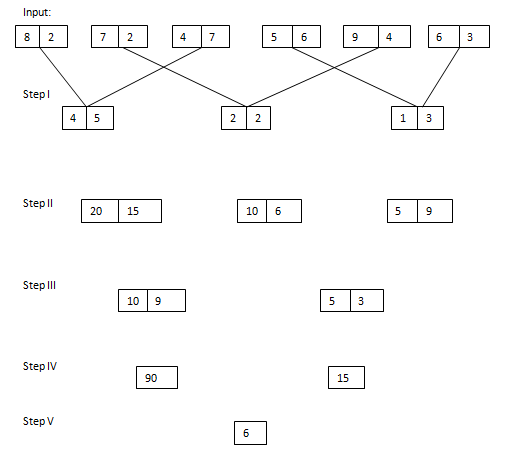
Logic:
Step I: The difference of first digit of first and third numbers. And difference of second digit of first and third number. The similar method is followed for second and fourth number, fourth and sixth number.
Step II: The first digit of the number should be multiplied by 5. Second digit should be multiplied by 3.
Step III: The difference of first digit of first number and first digit of second number is in first digit of first number in STEP III. The difference of second digit of first number and second digit of second number is in second digit of first number in STEP III. This same method is applicable for second number and third number.
Step IV: Multiple of two digits in Step 3 form the number in Step IV.
Step V: By dividing biggest number to the smallest number in previous steps will give Step V.
6) Answer: d)
7) Answer: e)
8) Answer: c)
9) Answer: a)
10) Answer: a)
Direction (11-15):

i). R sits second to the left of T.
ii). R sits at extreme end of the line.
iii). The Person who takes leave on Wednesday sits at extreme end of the table.
iv). Only two people sits between R and the person whose age is 32.
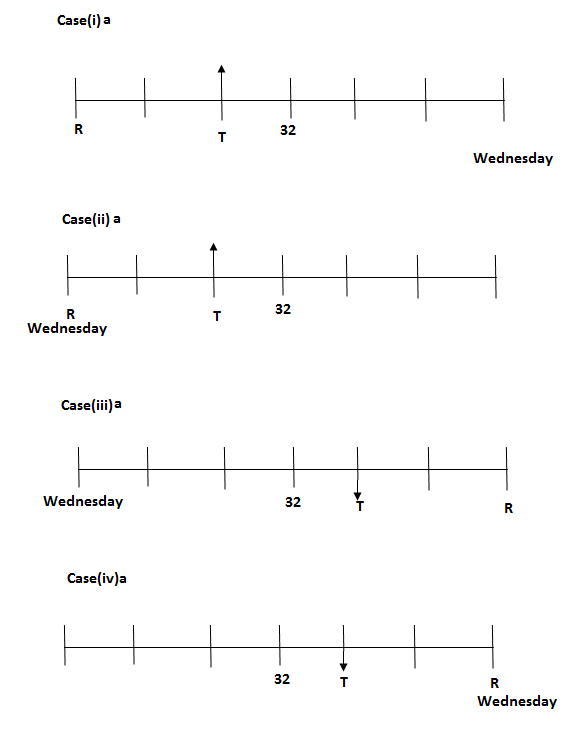
v). The person who takes leave on Tuesday sits second to the left of the person whose age is 32.
vi). The person who takes leave on Tuesday was 21 years old.
vii). P’s age is 38 and he takes leave on Saturday, who is not immediate neighbour of the person whose age is 32.
viii). The person whose age is 38 sits immediate left of the person whose age is 40, who does not sit second to the right of the person whose age is 32.
ix). The person whose age is 40 takes leave on Monday.
x). The person who takes leave on Monday does not sit at extreme end of the line.
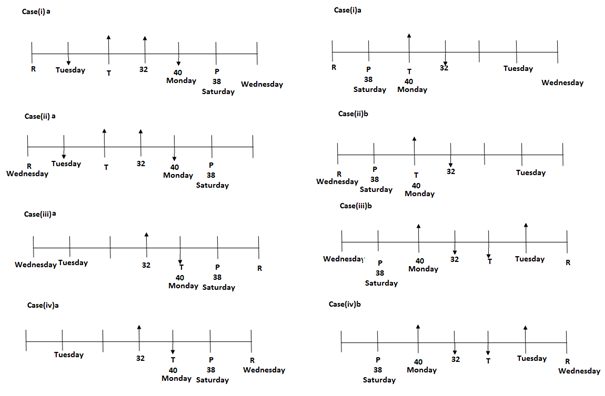
xi). The eldest person of the group is V, who sits second to the right of U.
xii). U sits immediate left of S.
xiii). U faces North.
xiv). U takes leave on first day of the week, who does not sits at extreme end of the row.
xv). The person who takes leave on Thursday sits third to the left of the person who takes leave on Wednesday.
xvi). Immediate neighbour of R faces same direction of R.
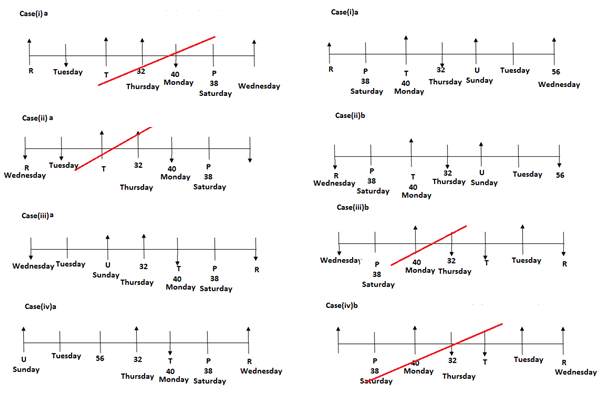
xvii). P sits second to the right of Q, who is an immediate left of the youngest person.
xviii). R not takes leave on Friday.
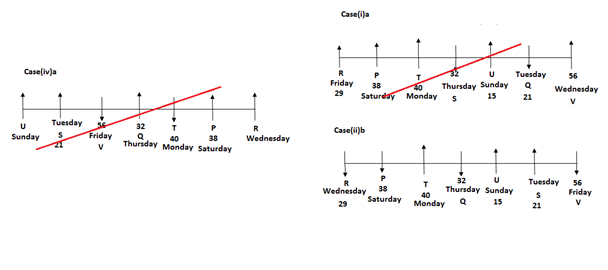

11) Answer: a)
12) Answer: a)
13) Answer: D)
14) Answer: B)
15) Answer: d)
Direction (16-18)
16) Answer: e)
Assumption I: By construction dams and rain water harvesting method may increase the drinking water level.
Assumption II: It benefits to farmers.
17) Answer: e)
Assumption I and Assumption II are related to the given Statements, So both assumption I and II are implicit.
18) Answer: b)
Assumption I – are not related to the given Statements
Assumption II – Both Assumption II and Statement are indirectly related to avoid pollution.
Direction (19-20)
19) Answer: b)
Now Muthoot Fincorp Limited is jointed his hands with NSDC to train graduates is the effect of the cause, India has many unemployed graduates.
20) Answer: a)
The Uttarakhand government felt that, the environment was getting damaged a lot is the cause. So, Uttarakhand high court banned water sports.
Daily Practice Test Schedule | Good Luck
| Topic | Daily Publishing Time |
| Daily News Papers & Editorials | 8.00 AM |
| Current Affairs Quiz | 9.00 AM |
| Quantitative Aptitude “20-20” | 11.00 AM |
| Vocabulary (Based on The Hindu) | 12.00 PM |
| General Awareness “20-20” | 1.00 PM |
| English Language “20-20” | 2.00 PM |
| Reasoning Puzzles & Seating | 4.00 PM |
| Daily Current Affairs Updates | 5.00 PM |
| Data Interpretation / Application Sums (Topic Wise) | 6.00 PM |
| Reasoning Ability “20-20” | 7.00 PM |
| English Language (New Pattern Questions) | 8.00 PM |





